Physical Address
304 North Cardinal St.
Dorchester Center, MA 02124
The disorders of red blood cells can be divided into those of decreased red blood cell (RBC) mass (anemias) and those of increased RBC mass (erythrocytoses). Most of this chapter is devoted to various types of anemias, with only a short discussion of erythrocytosis.
From the pathophysiologic standpoint, anemias can be divided into three categories ( Box 1.1 ): anemias of blood loss, anemias of decreased RBC production, and anemias caused by increased RBC destruction (hemolysis). Each of these categories can be subdivided further, as illustrated in Box 1.1 and subsequent sections.
Anemias of blood loss
Acute
Chronic
Anemias of decreased red blood cell production
Ineffective erythropoiesis
Megaloblastic anemia
Iron deficiency
Myelodysplastic syndromes
Sideroblastic anemia
Congenital dyserythropoietic anemia
Decreased effective erythropoiesis
Stem cell defects
Marrow replacement processes
Anemia of chronic kidney disease
Anemia of chronic disease
Hemolytic anemias
Intrinsic red cell defects
Hemoglobin disorders
Structural hemoglobin disorders
Sickling diseases
Hemoglobin C disease
Thalassemias
Red cell membrane disorders
Hereditary spherocytosis
Hereditary elliptocytosis
Hereditary pyropoikilocytosis
Red cell enzyme disorders
Glucose-6-phosphate dehydrogenase deficiency
Paroxysmal nocturnal hemoglobinuria
Extrinsic red cell defects
Autoimmune hemolytic anemia
Warm
Cold
Microangiopathic hemolytic anemia
Parasitic hemolysis
Malaria
Babesia
Relative erythrocytosis (decreased plasma volume)
Absolute erythrocytosis (polycythemia)
Primary
Polycythemia vera
Primary familial polycythemia
Secondary
Chronic hypoxia
Cardiac disorders
Pulmonary disorders
Sleep apnea
High-altitude residence
Hemoglobin abnormalities
High-oxygen-affinity hemoglobins
Increased carboxyhemoglobin (smokers)
Aberrant erythropoietin production by tumors
Other rare congenital causes of secondary polycythemia (e.g., Chuvash polycythemia)
This chapter focuses on commonly encountered conditions. Various rare causes of anemia and some disorders lacking characteristic changes in peripheral blood or bone marrow are omitted.
Blood loss, the most common cause of anemia, can occur as obvious bleeding from trauma, occult bleeding (e.g., gastrointestinal ulcers, uterine fibroids), induced bleeding secondary to surgery, hemodialysis, or repeated diagnostic testing. Blood loss can be acute or chronic. The anemia of acute blood loss, such as that associated with major trauma, is not immediately evident based on complete blood cell count (CBC) parameters because losses consist of whole blood, and the vascular system contracts on the decreased blood volume. However, with intravascular volume repletion, the erythrocytes will be diluted and the degree of RBC and hemoglobin (Hb) loss will be manifest on the CBC.
Chronic, low-level blood loss is initially compensated by increased marrow RBC production; therefore no anemia will be present, although reticulocytosis may be evident. With prolonged blood loss, body iron stores become depleted, the iron-deficient marrow is no longer able to compensate, and iron deficiency anemia (IDA) develops. Thus the anemia of chronic blood loss is essentially IDA (see the following section).
Anemias of decreased red blood cell production can be divided into those due to ineffective erythropoiesis and those due to a decrease in effective RBC production.
Anemias of ineffective erythropoiesis are characterized in general by a failure of the marrow to produce adequate mature erythrocytes, despite erythroid hyperplasia in the marrow, and often demonstrate morphologic abnormalities in erythroid precursors, mature RBCs, or both. The defect may be primarily one of nuclear maturation (megaloblastic anemia) or cytoplasmic maturation (iron deficiency). Myelodysplastic syndromes, although often characterized by ineffective erythropoiesis, are discussed in Chapter 18 .
The megaloblastic anemias are macrocytic anemias associated with characteristic morphologic features of hematopoietic cells. Cytopenias are due to impaired deoxyribonucleic acid (DNA) synthesis, which leads to abnormal nuclear maturation of hematopoietic precursors and ineffective hematopoiesis. The major causes of megaloblastic anemia are folate deficiency and cobalamin (Cbl; vitamin B 12 ) deficiency. Folate in the form of tetrahydrofolate (THF) is a transporter of 1-carbon units, used for synthesis of purines, thymidine, and methionine ( Fig. 1.1 ). Cbl is a required intermediate in an intracytoplasmic reaction that converts methyltetrahydrofolate, the main form of folate transported in plasma and taken up by cells, into THF while transferring the methyl group to homocysteine to generate methionine. Therefore either folate or Cbl deficiency impairs thymidine and methionine synthesis. Cbl also serves as a cofactor for intramitochondrial conversion of methylmalonyl-coenzyme A to succinyl-coenzyme A (not illustrated).
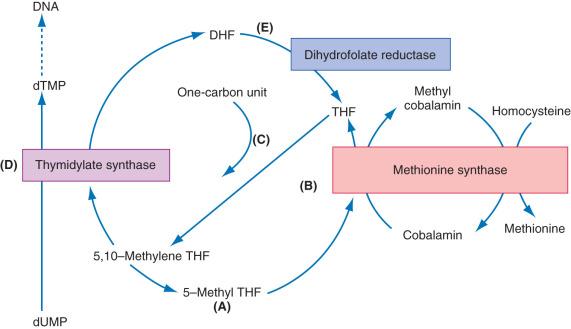
Because Cbl is produced in nature only by microorganisms, humans must obtain it from their diet. Food sources include red meat, seafood, and dairy products. After ingestion, Cbl is released from food in the stomach in the presence of pepsin and gastric acid and then binds to haptocorrins (R-proteins) secreted in saliva. However, in the alkaline milieu of duodenum, haptocorrins are degraded by pancreatic enzymes, permitting Cbl to bind to intrinsic factor secreted by gastric parietal cells. Intrinsic factor–Cbl binds to receptors specific for this complex on ileal enterocytes and is absorbed. A small proportion of Cbl can also passively diffuse through gastrointestinal mucosa. A fraction of Cbl is bound to the transporter protein, transcobalamin II (TC II), in the plasma and is the biologically active component available for receptor-mediated cellular uptake; however, a larger proportion of plasma Cbl is bound to haptocorrins. In summary, the Cbl absorption depends on adequate dietary intake, gastric acid and pepsin, pancreatic proteases, gastric-derived intrinsic factor, and ileal receptors for intrinsic factor–Cbl complex. Disruption of any factor along this pathway may lead to Cbl deficiency.
The body stores a large amount of Cbl; therefore it may take several years for deficiency to develop, even with the onset of severe dietary insufficiency or malabsorption. Cbl deficiency is most often caused by malabsorption. Autoimmune gastritis resulting in a lack of intrinsic factor (i.e., pernicious anemia) is a common cause, but malabsorption of Cbl may also be due to other gastric disease (e.g., atrophic gastritis, Helicobacter pylori infection), ileal disease (e.g., inflammatory bowel disease, tropical sprue), postsurgical malabsorption, pancreatic insufficiency, drugs (e.g., proton pump inhibitors, histamine H 2 –receptor agonists, biguanides), chronic alcoholism, and competition for dietary Cbl (e.g., intestinal bacterial overgrowth, fish tapeworm). Overt Cbl deficiency is rarely due to isolated dietary insufficiency, but a devastating exception to this occurs among exclusively breast-fed infants of mothers who have subclinical Cbl insufficiency that may be related to a vegan diet or occult malabsorption. These infants have increased risk for neural tube defects including spina bifida and anencephaly. In rare cases, Cbl deficiency can be caused by congenital deficiency of TC II.
In contrast to Cbl, the amount of folate body stores is sufficient for only about 4 months, and, thus folate deficiency is more often related to a poor diet. Important dietary sources for folate include leafy vegetables, fruit, cereals, and fortified flour and grains. Other causes of folate deficiency are increased demand (e.g., pregnancy, prematurity, chronic hemolytic anemia, severe exfoliative dermatitis, leukemias), loss due to hemodialysis, drugs, and competition for dietary folates (intestinal bacterial overgrowth). Malabsorption of folate is rare unless there is extensive intestinal disease (e.g., gluten-induced enteropathy, tropical sprue).
The hematologic manifestation of Cbl and folate deficiency is megaloblastic anemia. The onset of anemia is gradual, and the severity at presentation is extremely variable. Some patients exhibit profound macrocytic anemia with Hb levels as low as 2 g/dL, whereas other patients may have a more subtle manifestation or present with symptoms other than anemia. Due to defective DNA synthesis, ineffective erythropoiesis or intramedullary hemolysis can lead to jaundice, markedly increased lactate dehydrogenase, and increased indirect bilirubin. The ineffective hematopoiesis and hemolysis may be so pronounced that haptoglobin is reduced and hemosiderinuria occurs. The mean corpuscular volume (MCV) is characteristically high, with clinically overt megaloblastic anemia, but may also become elevated before the development of detectable anemia. However, the MCV may be in the normal range if there is concurrent iron deficiency anemia or thalassemia. The reticulocyte count is low. Leukopenia and thrombocytopenia are often present because impairment of DNA synthesis affects all proliferating cells.
The effect of Cbl deficiency on epithelial cells may result in the classic “beefy red smooth tongue” (atrophic glossitis). More important, Cbl deficiency is often associated with a peripheral neuropathy and demyelinization of the dorsal and lateral columns of the spinal cord (i.e., subacute combined degeneration), leading to paresthesias, loss of position and vibration sense, spastic ataxia, and extensor plantar reflexes. Cognitive impairment may be seen; psychosis is a rare complication. Neurologic complications of Cbl deficiency may be only partially reversible, making early recognition of this disorder essential.
Macrocytic anemia due to folate deficiency, cobalamin deficiency, and other causes, resulting in impaired DNA synthesis, abnormal nuclear maturation, and ineffective hematopoiesis
Folate deficiency is rare in countries with mandatory food fortification
Dietary cobalamin deficiency is rare, except among vegans and populations with low intake of animal-source foods
Increased risk of fetal neural tube defects in folate/Cbl-deficient pregnancy
Peripheral neuropathy, subacute combined degeneration of the spinal cord, and cognitive abnormalities that may be only partially reversible (cobalamin deficiency)
Increased risk of gastric adenocarcinoma and carcinoid tumor (patients with pernicious anemia)
Prevalence estimates based on low red blood cell (<140 ng/mL) and serum (<3 ng/mL) folate levels among women of childbearing age in the United States is 4.5% and 0.3%, respectively (2005–2006 National Health and Nutrition Examination Survey)
Increased incidence of cobalamin deficiency in breast-fed infants and young children among populations at risk of dietary insufficiency (strict vegans and developing countries)
Prevalence of cobalamin deficiency owing to malabsorption increases with age
Gradual onset of macrocytic anemia
Evidence of hemolysis (jaundice, elevated lactate dehydrogenase, elevated total bilirubin, low haptoglobin)
Atrophic glossitis
Neuropsychiatric effects (cobalamin deficiency)
Paresthesias
Loss of position and vibration sense
Ataxia
Cognitive impairment (impaired memory, dementia)
Psychosis (rare)
Treatment of the underlying cause of the deficiency
Intramuscular injection (or large oral doses) of vitamin B 12
Oral folate supplementation (parenteral administration needed in some cases)
In clinically overt megaloblastic anemia, the peripheral blood film demonstrates marked variability in red cell size (anisocytosis), with large, oval red cells (macroovalocytes), teardrop cells, fragments, microcytes, and other nonspecific abnormally shaped red cells (poikilocytes; Fig. 1.2 ). Polychromasia is characteristically absent. With increasing severity, there is increased red cell fragmentation. Howell-Jolly bodies, nucleated RBCs with megaloblastic morphology, and basophilic stippling are often observed ( Fig. 1.3 ). Hypersegmented neutrophils with six or more nuclear lobes, in combination with macrocytic anemia, are highly specific for megaloblastic anemia ( Fig. 1.4 ).
Anemia, often pancytopenia
Prominent anisocytosis
Poikilocytosis
Macroovalocytes
Teardrop cells
Fragments
Lack of polychromasia
Hypersegmented neutrophils
Howell-Jolly bodies, nucleated red cells, basophilic stippling
Hypercellular marrow with trilineage expansion
Left-shifted hematopoietic precursors
Asynchronous nuclear to cytoplasmic maturation
Megaloblastic erythroid precursors
Giant metamyelocytes
Larger than normal megakaryocytes with abnormal nuclei
Other causes of megaloblastic hematopoiesis
Drugs
Some myelodysplastic syndromes
Nonmegaloblastic macrocytosis
Reticulocytosis
Liver disease
Alcohol
Hypothyroidism
Drugs
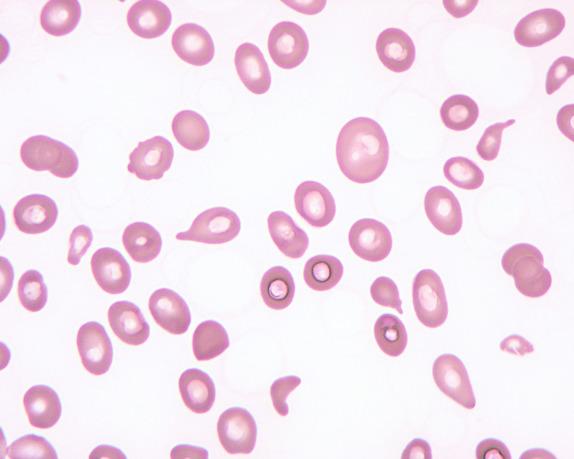
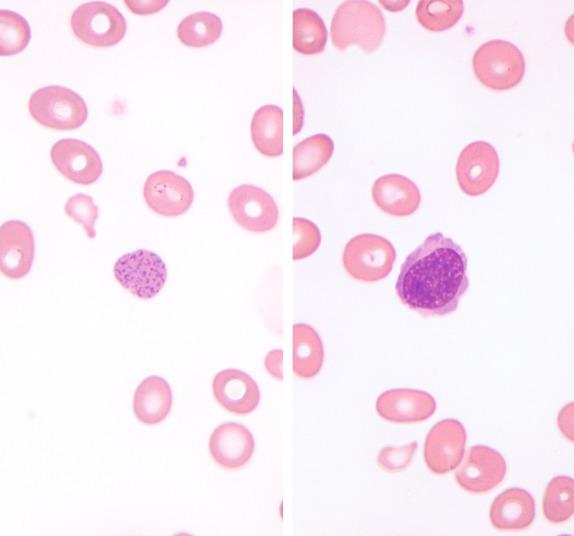
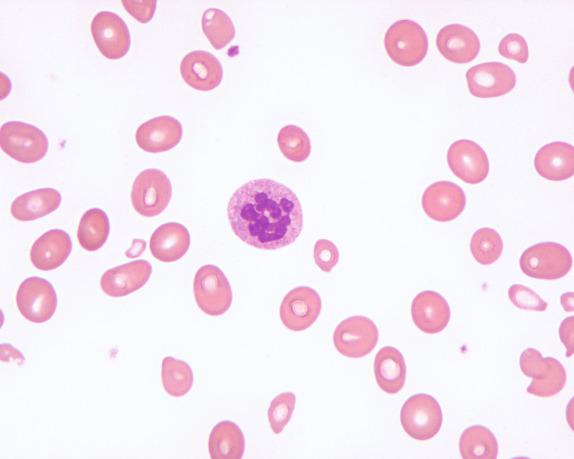
Bone marrow aspirate smears typically demonstrate erythroid hyperplasia and a shift to immaturity, as well as characteristic cytologic changes in all three myeloid lineages. Maturing cells are larger than normal, with asynchronous nuclear and cytoplasmic maturation. The chromatin of the erythroid precursors appears more granular than during normal maturation, and the most mature erythroid precursors display a prominent fenestrated nuclear appearance that contrasts with the expected complete condensation of chromatin at this stage ( Fig. 1.5 ). Erythroid precursors with abnormally shaped, multiple, budding, or fragmented nuclei are often seen ( Fig. 1.6 ), resembling those seen in myelodysplastic syndromes. Giant metamyelocytes and bands with abnormally open chromatin are also characteristic ( Figs. 1.5 and 1.7 ), whereas larger than normal megakaryocytes with unattached nuclear lobes or hyperlobated nuclei reflect similar abnormalities in megakaryocytic maturation. Because of the pronounced ineffective hematopoiesis, markedly increased iron stores are seen with a Prussian blue iron stain unless there is concurrent iron deficiency. Bone marrow core biopsy specimens demonstrate a markedly hypercellular marrow with expanded and left-shifted trilineage hematopoiesis ( Fig. 1.8 ). In particular, islands of immature erythroid precursors with finely stippled chromatin and distinct, irregular, eosinophilic nucleoli are often prominent ( Fig. 1.9 ).
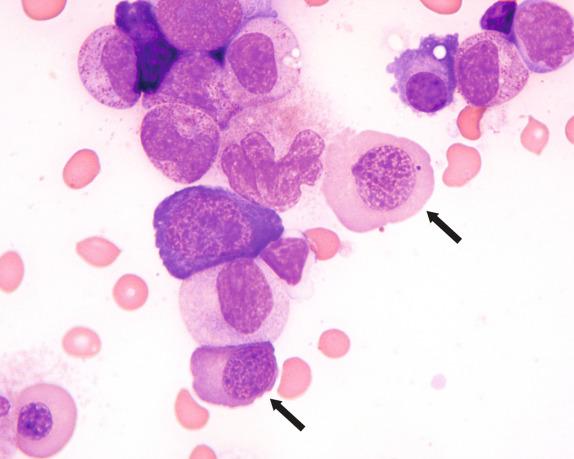
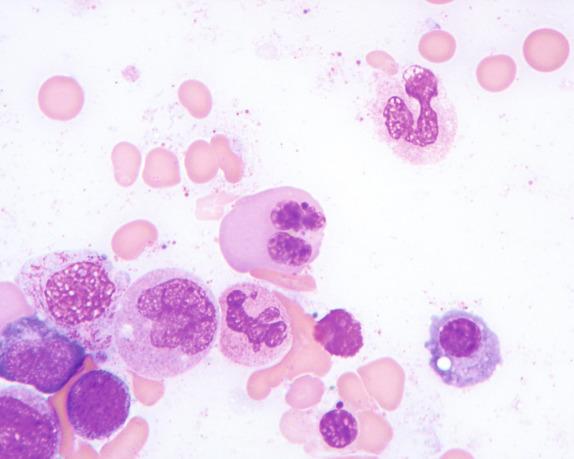
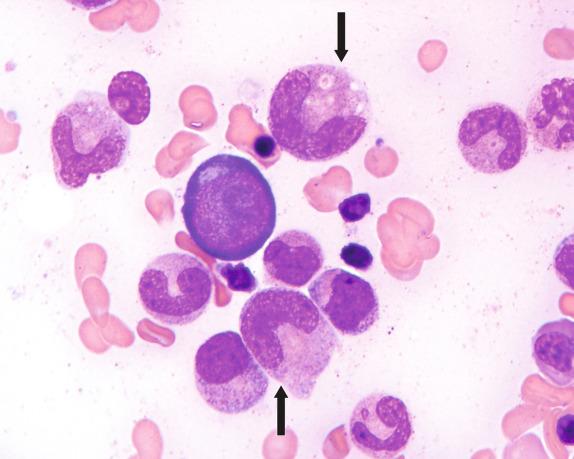
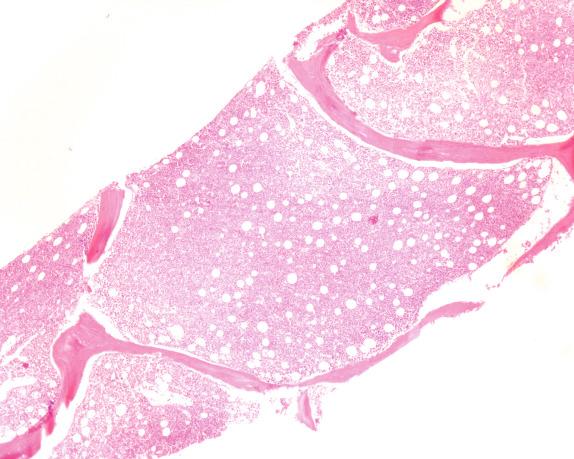
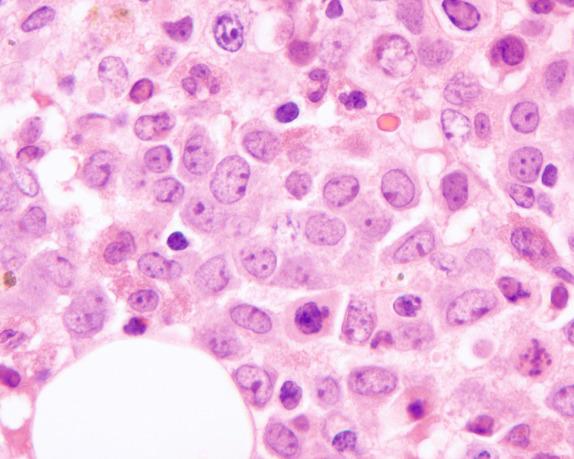
Serum Cbl is fairly sensitive and specific for clinically overt Cbl deficiency. Causes of falsely low serum Cbl include pregnancy, use of oral contraceptives, anticonvulsant administration, human immunodeficiency virus infection, and folate deficiency. Mixed Cbl/folate deficiency complicates the interpretation of the laboratory workup of megaloblastic anemia ( Table 1.1 ). Falsely normal levels of Cbl are rare with clinically overt deficiency but may be observed in association with myeloproliferative disorders, liver disease, intestinal bacterial overgrowth, and congenital TC II deficiency. Detection of antibodies to intrinsic factor helps to determine the cause of a Cbl deficiency and to confirm a diagnosis of pernicious anemia.
| B 12 Deficiency | Folate Deficiency | Mixed B 12 /Folate Deficiency | Myelodysplastic Syndrome | |
|---|---|---|---|---|
| Serum folate | Normal/high | Low/normal | Low | Normal |
| Red blood cell folate | Low/normal | Low | Low | Normal |
| Serum cobalamin | Low/normal | Normal/low | Low | Normal/low |
| Methylmalonic acid | High | Normal | High | Normal |
| Homocysteine | High | High | High | Normal |
Folate status may be assessed by either serum or red cell folate assays. Serum folate may occasionally be misleading due to fluctuations related to short-term dietary changes. Hemolysis (in vivo and in vitro) will cause falsely elevated serum folate, whereas alcohol intake can cause transient low levels despite adequate stores. Red cell folate levels better reflect body folate stores and are less prone to short-term fluctuation. Importantly, Cbl deficiency can cause reduced red cell folate levels, but this is usually associated with normal or increased serum levels (see Table 1.1 ).
Measurements of serum homocysteine and methylmalonic acid are also useful in the assessment of megaloblastic anemia. Homocysteine accumulates in both Cbl and folate deficiency because of interruption of the biochemical pathway illustrated in Fig. 1.1 . Unlike folate deficiency, Cbl deficiency is associated with an increase in serum methylmalonic acid because of interruption of the conversion of methylmalonyl-coenzyme A to succinyl-coenzyme A. A normal methylmalonic acid level generally rules out Cbl deficiency; however, both metabolites may be mildly elevated with renal insufficiency. Elevated serum homocysteine may also be seen with vitamin B 6 deficiency, vitamin B 2 (riboflavin) deficiency, hypothyroidism, some drugs, and genetic mutations affecting metabolism of homocysteine.
The major differential diagnoses of megaloblastic anemia owing to folate or Cbl deficiency are megaloblastic changes related to drug therapy and myelodysplastic syndromes. A variety of agents that interfere with DNA synthesis can cause megaloblastic changes in maturing marrow elements, including methotrexate, zidovudine, hydroxyurea, and azathioprine. Megaloblastic morphology due to drugs tends to be confined to the erythroid compartment, although this may not be the case with long-term administration. In general, an accurate drug history and biochemical tests for folate and Cbl deficiency will distinguish this cause of megaloblastosis.
Megaloblastic anemia may be confused with myelodysplastic syndromes because of the potential for dyserythropoiesis in megaloblastic anemia or the potential for megaloblastic changes in myelodysplastic syndromes. However, when megaloblastic changes are seen in the erythroid elements of myelodysplastic syndromes, they are generally accompanied by a spectrum of other abnormalities that are not a feature of megaloblastic anemia, such as neutrophil hyposegmentation or hypogranularity, hypogranular platelets, hypolobated megakaryocytes, or increased blasts. Furthermore, giant bands and metamyelocytes as seen in megaloblastic anemia are usually not a notable feature of myelodysplastic syndromes. As a general rule, a very high MCV (more than 130 fL) would favor a megaloblastic anemia due to Cbl or folate deficiency versus other causes.
In addition to other causes of megaloblastosis, nonmegaloblastic macrocytosis can also enter into the differential diagnosis of megaloblastic anemia. These diagnoses include reticulocytosis, liver disease, alcohol abuse, drug effects, and hypothyroidism. Reticulocytosis is easily discerned either with a reticulocyte count or with prominent polychromasia on blood smear examination. Other causes of nonmegaloblastic macrocytosis do not produce the degree of anisopoikilocytosis, oval macrocytes, or hypersegmented neutrophils seen in megaloblastic anemia. Liver disease, in particular, is characterized by a uniform population of round macrocytic cells and target cells.
Standard therapy for Cbl deficiency, when the cause is not dietary deficiency, has traditionally been intramuscular injection of vitamin B 12 ; however, oral therapy is effective for some patients. To prevent adverse neurologic consequences because of concurrent or overlooked Cbl deficiency, Cbl status must be established before folate therapy is initiated. This may be difficult to do in practice because folate deficiency can cause low serum Cbl for reasons that are not well understood. If there is any doubt, Cbl supplementation should be administered along with folate therapy. Standard therapy for folate deficiency is oral supplementation. Parenteral administration of folate may be needed in cases caused by intractable malabsorption.
A sufficient iron supply is important for many biologic processes, but only impairment of Hb production and erythropoiesis owing to iron deficiency are addressed in this chapter. Iron serves as the ligand for binding of molecular oxygen to the porphyrin ring of heme. Anemia occurs from the inability of erythroid precursors to synthesize adequate Hb. Two stages of iron deficiency preceding anemia have been described. The first stage is iron depletion, and it is the earliest period during which other physiologic processes may be affected before an effect on erythropoiesis. Iron-deficient erythropoiesis then begins and, because of the longevity of the iron-replete red cells in circulation, continues for some time before development of overt anemia.
The risk of developing IDA depends heavily on age, diet, and regional or socioeconomic factors. The rapid utilization of iron during infancy, early childhood, and pregnancy as well as blood loss during childbirth and menstruation greatly increases the risk of IDA. Iron deficiency is widely accepted as the most common contributing cause for anemia overall. National Health and Nutrition Examination Surveys (2003 to 2006) from the United States estimated that iron deficiency was present in 14% of children 1 to 2 years old, 3.7% to 4.5% of children 3 to 5 years old, and 9% to 16% of nonpregnant females 12 to 49 years old. Inadequate dietary intake of iron is more frequent among impoverished populations. Parasitic infections, especially caused by hookworms and schistosomiasis, result in blood loss and are major contributing factors for IDA in some developing countries. In affluent societies, chronic blood loss, sometimes occult because of malignancy, is by far the most common cause of IDA. Malabsorption of iron can be due to gastrectomy, bariatric surgery, atrophic gastritis, Helicobacter pylori infection, and celiac disease.
Most signs and symptoms are those seen in any form of anemia, such as fatigue, dyspnea, and pallor of skin and mucous membranes. Because the anemia develops over a protracted period and compensatory mechanisms have ample time to develop, IDA is surprisingly well tolerated, even when extremely severe. Pica, koilonychia (i.e., spoon-shaped nails), and esophageal webs are rare but have a strong association with IDA. Angular cheilitis and atrophic glossitis can also be seen but are not specific. The anemia ranges from mild to profound, with Hb levels as low as 2 g/dL in the most severe cases. IDA typically is a microcytic and hypochromic anemia, reflected as a decreased MCV and mean corpuscular Hb concentration (MCHC), respectively. However, the MCV may be normal in early iron deficiency; the degree of microcytosis roughly correlates with the degree of anemia. Likewise, the MCHC may be normal in early iron deficiency when only a minority of cells is hypochromic.
Anemia owing to inadequate iron supply
Most common cause of anemia worldwide
Reduced quality of life and reduced productivity
Probably increased maternal and fetal–neonatal morbidity and mortality
Probably reduced cognitive development in children
Increased incidence in infants, children, women of childbearing age, and impoverished populations, particularly in underdeveloped countries
Increased incidence in some minorities compared with white population in the United States
General signs and symptoms of chronic anemia
Angular cheilitis, glossitis, pica, koilonychia, and esophageal webs
Oral iron supplementation
Parenteral iron in patients with uncontrolled blood loss, intolerance to oral iron, or intestinal malabsorption
The characteristic findings on the peripheral blood film are small (microcytic), under-hemoglobinized (hypochromic) RBCs with variability in size (anisocytosis) and abnormal shapes (poikilocytosis; Fig. 1.10 ). Elliptocytes are prominent poikilocytes in IDA; often they are long and narrow (pencil cells). Target cells, teardrop cells, very small hypochromic microcytes, and various nonspecific poikilocytes are also common. Occasional red cell fragments may be observed, but they are not prominent. Thrombocytosis is common, but platelet counts may also be normal or reduced. Variations from the typical findings occur when there has been recent partial repletion of iron or when additional factors, such as Cbl or folate deficiency, are also contributing to anemia.
Hypochromic, microcytic red blood cells
Anisocytosis
Lack of polychromasia
Poikilocytosis, including elliptocytes, target cells, and teardrop cells
Thrombocytosis may be present
Mild erythroid hyperplasia
Absent stainable iron on a Prussian blue–stained aspirate smear
Thalassemia trait or thalassemia-like hemoglobinopathy
Anemia of chronic disease
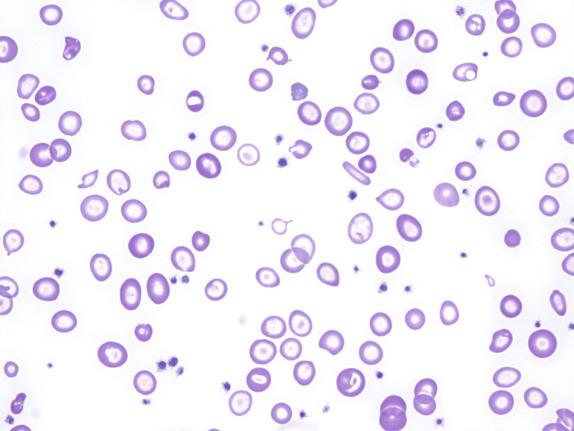
The bone marrow in IDA may demonstrate erythroid hyperplasia, but this is generally of only a mild degree. Erythroid precursors may have scant cytoplasm with frayed cytoplasmic borders.
Serum ferritin measurement is the most useful single laboratory test for iron deficiency. Serum ferritin below the lower limit of the reference range (about 12 mg/dL) is essentially diagnostic of iron deficiency. However, ferritin is an acute-phase reactant, and normal levels may be seen when iron deficiency coexists with infection, inflammation, or malignancy. When this occurs, the ferritin level will usually be low-normal; therefore low-normal values in an individual with an active inflammatory process support a diagnosis of iron deficiency in the appropriate setting. Ferritin levels may even be higher in patients with acute liver injury, despite iron deficiency. Measurement of serum iron alone is not useful because of diurnal fluctuations of serum iron levels and the rapid changes that may occur with dietary intake, inflammation, and blood loss. Transferrin, measured either directly or indirectly as the total iron-binding capacity, is typically increased in IDA, but this response can be blunted in the presence of hypoproteinemia. The transferrin saturation (the ratio of serum iron to total iron-binding capacity) is typically less than 15% in iron deficiency, but saturation levels in this range may also be seen in anemia of chronic disease (ACD).
Increased serum soluble transferrin receptor (sTfR) is a sensitive marker of iron deficiency, reflecting increased expression of this receptor on RBC precursors as a response to depleted tissue iron. This parameter is elevated during iron-deficient erythropoiesis before the development of overt anemia. Furthermore, inflammation does not raise sTfR levels substantially. However, conditions with an increased mass of RBC precursors such as hemolytic anemias and ineffective erythropoiesis (e.g., megaloblastic anemia) will manifest elevated sTfR; therefore this finding is not specific for iron deficiency.
When biochemical tests are equivocal, the absence of stainable iron on a Prussian blue–stained marrow aspirate smear with adequate spicules is considered to be the gold standard for the diagnosis of IDA. An iron stain performed on a bone marrow core biopsy may also be helpful, but iron can be leached out during decalcification of the bone marrow biopsy and result in the false interpretation of absent iron stores.
In IDA, hepcidin level is generally suppressed. Hepcidin blocks iron absorption from the diet and the iron release from macrophages and liver cells. Although measurement of serum hepcidin is helpful, development of an accurate clinical assay is challenging.
Other common causes of hypochromic, microcytic anemia are thalassemia and ACD. Sideroblastic anemia with microcytosis is rarer. The hematologic and biochemical tests that are useful to differentiate the major causes of microcytic anemia are listed in Table 1.2 . In addition, mild anemia associated with thalassemia trait or a thalassemia-like hemoglobinopathy (e.g., Hb E) characteristically exhibits a red blood cell count greater than 5 × 10 12 cells/L, which is unusual for IDA. Hb electrophoresis would help establish the diagnosis of most β-thalassemias and thalassemia-like hemoglobinopathies. Patients with ACD are also at risk of developing IDA. Serum hepcidin can help identify concomitant IDA in this situation because levels are lower compared to pure ACD. When the interpretation of biochemical studies for iron status is particularly difficult, monitoring the response of Hb or the reticulocyte count to a trial of iron supplementation may be sufficient to confirm iron deficiency. An iron stain performed on a bone marrow aspirate smear can also help to resolve uncertainty about iron status.
| Laboratory Feature | Iron Deficiency Anemia | Thalassemia | Anemia of Chronic Disease |
|---|---|---|---|
| Increased anisocytosis (elevated RDW) | Present | Absent or present | Typically absent |
| Increased reticulocytes | Typically absent | Absent or present | Absent |
| Bone marrow iron stores | Absent | Normal or increased | Typically increased; sideroblasts reduced |
| Serum ferritin | Typically reduced | Normal or increased | Typically increased |
| Serum iron | Typically reduced | Normal or increased | Typically reduced |
| TIBC | Typically increased | Normal or reduced | Reduced or normal |
| Transferrin saturation | Typically decreased | Normal or increased | Normal or reduced |
| Serum transferrin receptor | High | Normal or high | Normal or increased |
Iron supplementation with oral iron salts, most commonly ferrous sulfate, is standard therapy for uncomplicated IDA. Response to iron supplementation is usually rapid if the iron deficiency is the result of inadequate iron intake. If an appropriate response is not observed or when occult blood loss is more likely, additional evaluation to determine the cause of IDA should be considered. Parenteral iron may be needed for patients with uncontrolled blood loss, intolerance to oral iron, or malabsorption.
Because of the physiologic attempts to compensate for severe chronic anemia that has gradually developed, a rapid blood transfusion can result in hypervolemia and cardiac dilatation. Therefore red cell transfusions should be reserved for patients with severe anemia causing cardiac compromise.
Sideroblastic anemias (SA) are heterogeneous and characterized by anemia with ring sideroblasts in bone marrow. SA is caused by congenital or acquired defects affecting heme biosynthesis, iron-sulfur cluster biogenesis, or mitochondrial protein synthesis. Most present as isolated anemia. Rarely, SA can occur as a component of genetic syndromes with other metabolic or neuromuscular defects. Acquired SA can occur as a myeloid neoplasm (e.g., myelodysplastic syndrome with ring sideroblasts), which is frequently associated with mutations in protein constituents of the RNA spliceosome; this type will be discussed later (see Chapter 18 ). Acquired SA can also be a result of deregulated heme biosynthesis or mitochondrial function due to a variety of factors such as drugs, alcohol, or copper deficiency. Precipitating causes for copper deficiency include zinc toxicity, total parenteral nutrition without copper supplementation, and malabsorption syndromes.
The most common congenital form of SA is X-linked due to mutations in 5-aminolevulinate synthase ( ALAS2 ) and manifests predominantly in boys who have mild to moderate microcytic anemia. Girls with the same heterozygous mutations are usually asymptomatic. Autosomal-recessive SA due to mutated SLC25A38 , which encodes an erythroid mitochondrial transporter, usually presents in the first year of life with severe, transfusion-dependent microcytic anemia refractory to pyridoxine treatment.
Anemia with ring sideroblasts in bone marrow
Classified as congenital (X linked or autosomal inherited) or acquired (metabolic or clonal)
Congenital forms are rare with no ethnic predilection
Acquired forms are more common than congenital forms and occur sporadically
Major cause of death in severe cases is secondary hemochromatosis
Congenital forms are very rare
General symptoms of anemia
Rarely occurs as a part of a genetic syndrome with metabolic or neuromuscular manifestations
Congenital SA with mutated ALAS2 may respond to pyridoxine treatment
Severe forms are managed by transfusion and iron chelation
Allogeneic stem cell transplant may be curative for congenital forms
Removal of any offending agents is important in nonclonal acquired forms
The peripheral blood smear reveals anemia with dimorphic red blood cell morphology, including a distinct population of hypochromic red blood cells ( Fig. 1.11 ). The anemia in congenital SA is usually, but not always, microcytic, and the acquired forms are often not microcytic. Ring sideroblasts in bone marrow aspirate smears are the hallmark of SA and are due to deregulated iron metabolism and mitochondrial iron overload in the erythroid precursors ( Fig. 1.12 ). Hemosiderin-laden macrophages are increased due to ineffective erythropoiesis. A peculiar morphologic clue in bone marrow smears associated with copper deficiency is the presence of hemosiderin in plasma cells ( Fig. 1.13 ).
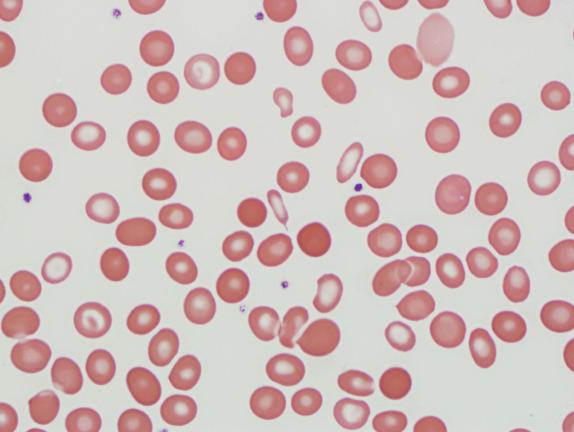
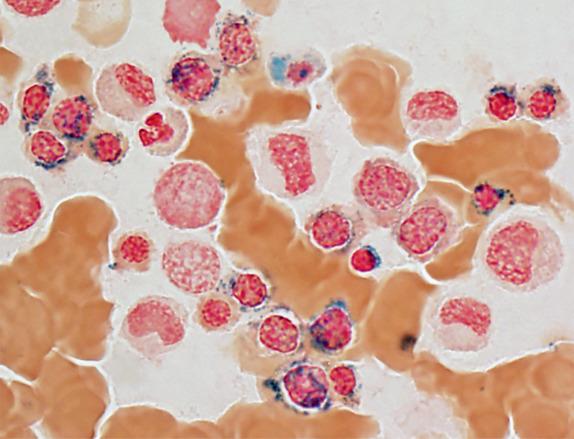
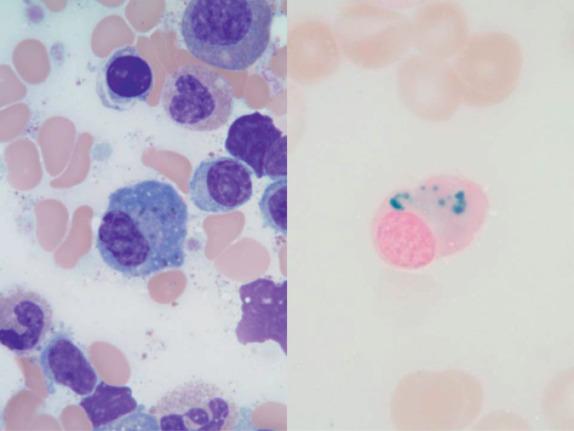
Iron studies often reflect associated iron overload. A definitive diagnosis of congenital SA can be made when specific mutations are identified. Evaluation for copper deficiency includes serum copper and ceruloplasmin.
The differential diagnosis for SA with microcytosis includes IDA, thalassemia, and ACD. Thus iron studies and hemoglobin electrophoresis are helpful. In adults, the acquired forms of SA are more common than congenital forms.
SA with mutated ALAS2 may respond to pyridoxine treatment. Transfusions with therapy to manage iron overload provides relief for patients with severe anemia. Hematopoietic stem cell transplantation has been successful in some patients with congenital SA. For acquired SA, the anemia is often reversible after the offending agents have been removed (e.g., alcohol, drugs) or treatment for copper deficiency has been implemented.
Congenital dyserythropoietic anemia (CDA) is a group of rare hereditary disorders characterized by anemia due to ineffective erythropoiesis and with distinct morphologic abnormalities of erythroblasts. Three classic subtypes (CDA I, II, III) and several minor variants have been identified. Mutations of the genes involved in most cases of CDA I and II have been identified, and more recently the genes involved in other types of CDAs have been described. CDA II is also known as hereditary erythroblastic multinuclearity with a positive acidified serum test (HEMPAS) owing to the susceptibility of the red blood cells to lysis in the acidified serum lysis test (HAM test). CDA III is rare outside of the few original families described.
The clinical spectrum is highly variable. CDA I and II are autosomal recessive, whereas CDA III is autosomal dominant. CDA II is the most common, and many patients come to attention as adults due to mild or moderate normocytic anemia associated with jaundice, splenomegaly, and/or hepatomegaly. Presentation of CDA I and III is similar to CDA II, but CDA I is usually macrocytic, comes to attention at a younger age, and can be associated with skeletal abnormalities. CDA I may also present as hydrops fetalis or as severe neonatal anemia. Cholelithiasis and rarely extramedullary hematopoiesis-related mass lesions can occur with CDA. Secondary hemochromatosis from iron overload is a major complication.
Anemia characterized by multinucleated erythroid precursors in the marrow and ineffective erythropoiesis
Rare
Rare severe forms may present as hydrops fetalis and stillbirth
Sporadic cases in a variety of ethnic groups
Variable anemia, splenomegaly, hepatomegaly, intermittent jaundice, and cholelithiasis
CDA I may present with severe neonatal anemia and can be associated with dysmorphic features
Mild to moderate forms have a good prognosis
Therapy is mainly transfusion and iron chelation
Allogeneic stem cell transplant is potentially curative
The peripheral blood film reveals various poikilocytes, basophilic stippling, and, in CDA II, occasional binucleated erythroblasts. The bone marrow shows erythroid hyperplasia and dyserythropoiesis. The nonerythroid lineages are morphologically normal. A highly specific feature for CDA I on bone marrow examination is thin chromatin bridges between paired erythroblasts. CDA II is often first recognized based on binucleated and rarely multinucleated erythroblasts in more than 10% of erythroid precursors. The binucleation is often restricted to the late-stage erythroblasts ( Fig. 1.14 ). CDA III is characterized by giant, multinucleated erythroblasts with up to 12 nuclei.
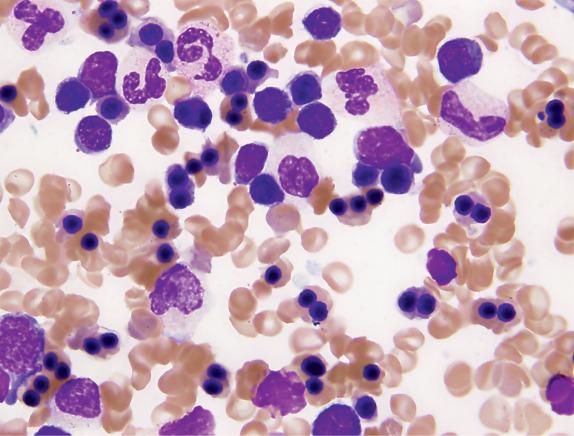
The diagnosis of CDA is based on long-standing hemolytic anemia with characteristic bone marrow findings and lack of an appropriate reticulocyte response. In the past, laboratory tests to confirm the diagnosis included a positive HAM test for CDA II, sodium dodecylsulfate polyacrylamide gel electrophoresis (SDS-PAGE) to identify hypoglycosylated membrane proteins in CDA II (e.g., band 3 is narrowed and shows faster migration), and electron microcopy for ultrastructural abnormalities distinct in CDA I, II, and III (e.g., “Swiss cheese–like” heterochromatin in CDA I and “double plasma membrane” in CDA II). When the clinical picture, peripheral blood, and bone marrow findings are compatible with a diagnosis of CDA, sequencing for known mutations can confirm the diagnosis in many cases and exclude other rare inherited anemias. A summary of some key features and mutated genes recognized so far for CDA is shown in Table 1.3 . The interested reader may consult the reference list for more information.
| Types | Inheritance Pattern | Key Bone Marrow Morphology | Mutated Gene |
|---|---|---|---|
| I | Autosomal recessive | Chromatin bridges between erythroblasts | CDAN1 , C15ORF41 |
| II | Autosomal recessive | Binucleated and multinucleated late-stage erythroblasts | SEC23B |
| III Familial | Autosomal dominant | Giant multinucleated erythroblasts | KIF23 |
| III Sporadic | Variable | Giant multinucleated erythroblasts | Unknown |
| Variants | Variable | Variable | KLF1 , GATA1 , unknown |
Clinically, CDA may be confused with thalassemia or hemolytic anemia. However, a relatively low reticulocyte count incommensurate to the degree of anemia and the unique bone marrow findings will lead to the correct diagnosis. CDA II is often misdiagnosed as hereditary spherocytosis (HS) due to hemolysis-related symptoms and occasional spherocytes in the peripheral blood. However, more numerous spherocytes and a greater reticulocyte response are expected for HS. The differential diagnosis of dyserythropoiesis includes many conditions such as B 12 /folate deficiency, exposure to heavy metals, copper deficiency, chemotherapy, medication effect, and myelodysplastic syndromes. However, the morphologic abnormalities predominant in the classic types of CDAs are distinct and not the main feature in any of these conditions.
Treatment depends on the type of CDA and the degree of anemia. Blood transfusions with therapy to prevent iron overload may be required for patients with more severe anemia. Interferon gamma may alleviate the symptoms of CDA I. Hematopoietic stem cell transplantation can be curative.
Variable anemia with or without macrocytosis
Anisopoikylocytosis
Erythroid hyperplasia
Thin chromatin bridges between paired erythroblasts in CDA I
Binucleated and rarely multinucleated erythroblasts in CDA II
Giant multinucleated erythroblasts in CDA III
Thalassemia
Hemolytic anemia (esp. hereditary spherocytosis)
Other causes for dyserythropoiesis (Cbl/folate deficiency, heavy metals, copper deficiency, chemotherapy, medication effect, myelodysplastic syndromes)
This group of anemias results from a decreased pool of erythroid stem cells available for maturation and proliferation or interference or blocking of the proliferation of an otherwise adequate stem cell pool, or both. Disorders belonging to this group include marrow failure syndromes, including aplastic anemia and pure red cell aplasia (discussed in Chapter 5 ), marrow replacement processes, anemia of chronic kidney disease (ACKD) and ACD. Only the last two are discussed in this chapter.
ACKD is primarily caused by underproduction of erythropoietin. Toxic metabolites related to uremia also likely contribute to ACKD by suppressing erythropoiesis, reducing red cell survival, and increasing the risk of blood loss due to platelet dysfunction.
There is variation in the level of renal function for which anemia develops, but the prevalence and severity of anemia increase as renal function decreases. Evaluation of National Health and Nutrition Examination Surveys (2007–2010) estimates that about 14% of the U.S. population has chronic kidney disease (CKD). Anemia has been estimated to be present in 15.4% of people with CKD, and the prevalence increases with stage of CKD. The prevalence of anemia is also higher and more severe among patients with diabetes, manifesting at earlier stages of CKD.
Progressive uremia leads to plasma expansion and hemodilution; therefore the Hb level immediately before hemodialysis is lower than that immediately afterward. Cardiovascular and renal attempts to compensate for anemia contribute to the development of left ventricular hypertrophy and can lead to congestive heart failure. Treatment with erythropoiesis-stimulating agents (ESAs), such as epoetin alfa or darbepoetin alfa, can improve the quality of life of these patients. However, the response to these therapies is limited if either absolute or functional iron deficiency develops. Functional iron deficiency is due to depletion of the iron pool immediately available for erythropoiesis. Mobilization of iron stores becomes rate limiting and is inadequate to meet the accelerated demand for iron during aggressive ESA therapy.
Anemia of variable degree primarily due to underproduction of erythropoietin
The prevalence and severity of anemia increase as renal function decreases
The prevalence and severity are increased in patients with diabetes
Prevalence varies with age, gender, and race or ethnicity
Higher prevalence of anemia among black versus white persons who have comparable levels of renal insufficiency
Associated with reduced quality of life, reduced cognitive function, left ventricular hypertrophy, and increased cardiac morbidity and mortality
General symptoms of chronic anemia
Optimal dialysis and nutrition
Erythropoiesis-stimulating agent therapy and iron supplementation
In ACKD, the peripheral blood film shows a normochromic, normocytic anemia with minimal polychromasia and minimal anisocytosis. Occasional echinocytes (burr cells) and other poikilocytes may be observed, such as acanthocytes and rare fragments. There is no increase in polychromasia.
Normocytic, normochromic anemia
Minimal polychromasia
Occasional poikilocytes, including echinocytes, rare acanthocytes, and fragments
Normocellular to slightly hypocellular marrow without an increase in erythroid precursors
Bony changes related to renal osteodystrophy may be observed
Iron deficiency anemia
Megaloblastic anemia
Anemia of chronic disease
Hypothyroidism
Secondary hyperparathyroidism
Aluminum toxicity
Pure red cell aplasia
The bone marrow is usually normocellular or slightly hypocellular; in the absence of ESA therapy, it contains normal to slightly reduced erythroid precursors. The amount of sideroblastic iron and storage iron will depend on overall iron status. Morphologic features of renal osteodystrophy may be noted on a bone marrow core biopsy specimen, especially in association with end-stage renal disease and in patients who have been treated with long-term dialysis. Renal osteodystrophy is a spectrum of abnormalities of bone turnover that variably exhibits thinning or thickening of bony trabeculae, excess osteoid without mineralization (osteomalacia), stromal fibrosis, and osteitis fibrosa cystica ( Fig. 1.15 ).
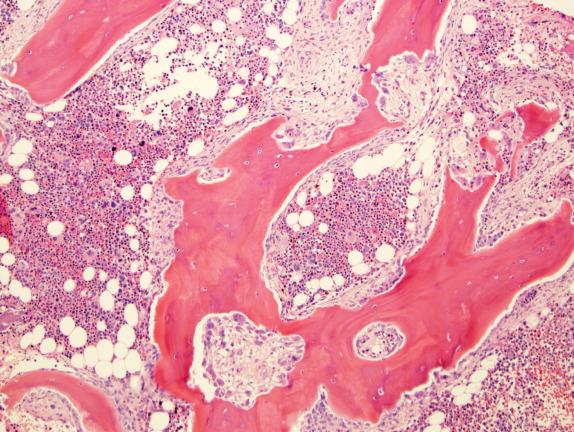
Plasma erythropoietin concentration and the reticulocyte count are inappropriately low for the degree of anemia in ACKD. An increase in reticulocytes is a helpful indicator of a response to therapy. However, measuring plasma erythropoietin concentration is not usually recommended.
Detection of concomitant iron deficiency may be compromised by the fact that patients with CKD may have associated inflammation; therefore ferritin levels may be difficult to interpret. Even more challenging is the detection of the functional iron deficiency that may compromise the effectiveness of ESA therapy. The small numbers of hypochromic RBCs produced in this circumstance will not be detected reliably by the MCV or MCHC. High-throughput hematology analyses provide additional parameters of hypochromia, which vary based on the manufacturer but which can help identify functional iron deficiency (e.g., percentage of hypochromic red cells, reticulocyte hemoglobin content, and low hemoglobin density).
Nutritional deficiencies, infections, and other causes of inflammation commonly have a role in the development of anemia in patients with CKD. In addition to malnutrition, blood loss associated with hemodialysis can contribute to iron deficiency. The diagnosis of iron deficiency in the setting of CKD is challenging due to poor predictive ability of serum iron indices. Recent guidelines (Kidney Disease: Improving Global Outcomes) recommend a course of iron therapy in patients with CKD and anemia if the transferrin saturation is less than 30% and the serum ferritin level is less than 500 mg/L. Patients receiving dialysis are also at increased risk of megaloblastic anemia, because Cbl and folate are water soluble and dialyzable.
Elevated markers of inflammation, such as C-reactive protein or erythrocyte sedimentation rate, indicate that chronic infection or inflammation may be contributing factors for anemia. Patients with high levels of inflammatory cytokines are more resistant to ESA therapy.
Hypothyroidism and secondary hyperparathyroidism can also contribute to anemia and resistance to ESA therapy among patients with CKD. Similar to ACKD, anemia related to hypothyroidism manifests with an inappropriately low reticulocyte response and is usually normocytic and normochromic. Aluminum toxicity associated with dialysis is another occasional cause of anemia in patients with renal failure; when chronic, this anemia becomes hypochromic and microcytic. In addition, a sudden lack of response to erythropoietin therapy could herald pure red cell aplasia caused by the development of antierythropoietin antibodies; however, this is rare and mostly related to a formulation that had been used outside of the United States.
Become a Clinical Tree membership for Full access and enjoy Unlimited articles
If you are a member. Log in here